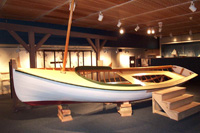- Site Map
- Donate |
- E-News Sign Up |
- Contact Us |
- Home |
Penn's Landing, Philadelphia PA
Open Daily 10am-5pm (215)413-8655

Events & Exhibits
Past Projects
Whirlwind: a 22' Shad Skiff
For the Museum's newest exhibit, What Floats Your Boat?, Museum staff decided to display a full-size replica of a traditional Delaware River boat.
After studying various types of boats once found along the Delaware, the exhibit designers decided to build a 22-foot long shad skiff, a boat once used to fish for shad. The shad skiff was built in the Museum's own boatshop, Workshop on the Water.
The images below show how the Museum's craftsmen built the shad skiff. Due to the large number of images, this page may take several minutes to load.
July 30, 2002 Step One: Lofting

Full scale drawings of the boat are are laid out on sheets of plywood. This process, called lofting, is done to create patterns for key parts of the boat. The lofting drawings will be used for reference throughout the building process.
Boatbuilder Roger Hammer is carefully checking the accuracy of patterns against the lofting drawing. The curved piece in the foreground is the stem, which will form the front of the boat.
August 7, 2002 Step Two: Mold Setup
A wooden mold created from the lofting drawings is bolted to the shop floor. The mold is upside down to facilitate attachment of key pieces of the boat's structural skeleton.
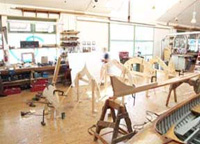
August 27, 2002 Step Three: Laying Down the Keel
Volunteer boatbuilder Carl Cross helps to install, or "lay down" in boatbuilding parlance, the boat's keel. Seen here spanning the length of the molds, the keel will serve as the boat's backbone.

September 10, 2002 Step Four: Planking
With the keel in place, boatbuilders Newt Kirkland and John Brady attach long strips of wood called planks. Eventually, the planks will completely cover the boat's ribs, forming the skin of the boat.
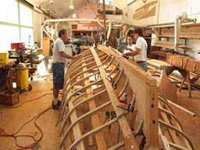
October 10, 2002 Step Five: Righting the Skiff
The skiff is now half-planked; the remaining half will be left unplanked to give visitors a look at the boat's structure. Here, the skiff is being turned right-side up to install the interior seating.
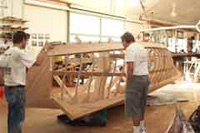
October 21, 2002 Step Six: Interior Seating
The boatbuilders are now installing the skiff's interior. Its seating will allow visitors to What Floats Your Boat? to actually climb into the skiff.
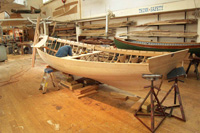
October 25, 2002 Step Seven: Interior Seating, Continued
Boatbuilders John Brady and Newt Kirkland examine the skiff's completed stern seating.
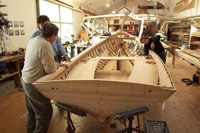
November 7, 2002 Step Eight: Staining & Painting
he skiff has now been moved into the What Floats Your Boat? exhibit gallery. Here, the final staining and painting work is being finished. Note that half the skiff's hull has been left unplanked.

November 16, 2002 The Completed Shad Skiff
After months of work, the shad skiff is now completely finished. Thanks to Morris Lowitz-Coia of Springfield, PA, the skiff also has a name, WHIRLWIND. Morris entered the name in the Museum's "Name the Shad Skiff" contest held in November 2002. Visitors to the What Floats Your Boat? exhibit are now free to climb aboard WHIRLWIND and explore this recreated piece of the Delaware Valley's maritime heritage.
Top